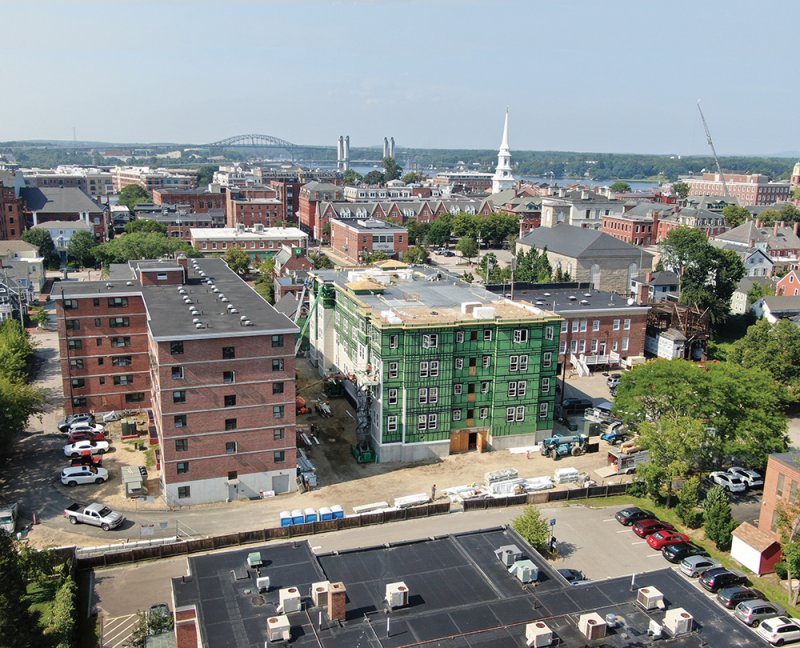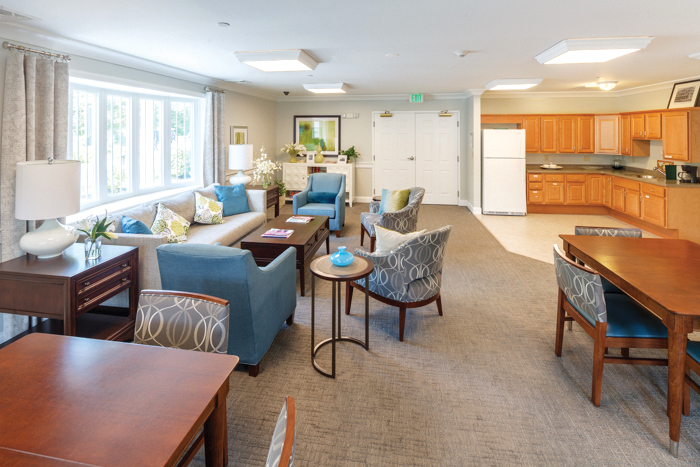
View from the rear of Ruth Lewis Griffin Place during construction in 2021.Courtesy of Eckman Construction.
While the state’s economy is strong in many respects, a workforce shortage, driven in large part by a housing shortage, continues to be a drag on economic growth. The good news is affordable housing projects are moving forward as municipalities around the state begin to understand the need and embrace measures that make it easier to develop.
The state legislature will, once again, tackle a laundry list of recommended changes addressing the pain points that have held back attempts to develop or delayed projects for years despite the existence of a workforce housing law for more than a decade. The law requires cities and towns to provide a “reasonable and realistic opportunity” for the development of workforce housing, which is ownership housing affordable to a household of four earning up to 100% Area Median Income (AMI) or for renters at 60% AMI while spending no more than 30% of a household’s income on housing costs.
In December 2021, NH Housing Finance Authority (NH Housing) issued a report on the state’s workforce housing law, “A 10-Year Retrospective on the Law’s Impact on Local Zoning and Creating Workforce Housing.” New Hampshire Housing Executive Director Rob Dapice says the report is helpful to understand not just the law but certain structures built around the law that can help municipalities understand it and make sure they are complying with it.
The report highlights education as one of the most critical pieces to addressing affordable housing, stating that it is important for state legislators and local leaders to understand the direct relationship between housing supply and statewide economic growth.
“Providing adequate housing opportunities for singles and young families so that they can stay in or relocate to New Hampshire is an essential part of this goal. No community should have an attitude that it is ‘someone else’s problem,’” the report states. “Direct involvement by State officials will be needed—ranging from providing funding to keep municipal and regional housing data updated to legislating negative consequences for communities who ignore or circumvent statutory requirements.”
The report also includes assessments of 33 municipalities that led to 10 case studies, which provide a more in-depth look at the nuances of each municipality’s approach, including the successes and challenges of creating land use regulations that provide reasonable and realistic opportunities for the creation of workforce housing.
“The difference between when the law was adopted and now is that the problem is worse and awareness is greater. So many more people are experiencing it themselves or someone they know and love is, and that makes it a good opportunity to provide the tools so that communities can take action,” says Dapice. “The world has changed as a result of the pandemic. It not only exacerbated challenges but the housing supply issue has been made all more visible. People are recognizing how severe the challenges are and are looking at innovative ways to create new housing.”
Legislative Answers
Senate Bill 400, with prime sponsor Republican Jeb Bradley and an additional 16 cosponsors, attempts to address the most significant roadblocks at the municipal level, from a lack of understanding of the need for workforce housing to removing unnecessary delays and expanding tax incentives.
“It has a ton of bipartisan support, a majority of the state Senate has signed on as cosponsors,” says Dapice. “I think it has a good chance of passage, and I think it will make a difference.”
The measure would require the state to develop self-training materials and tests for zoning boards of adjustment and planning boards, and make them available to cities and towns free of charge.
The bill would require municipalities that offer incentives for the development of senior housing, such as increased density or expedited approval, to offer the same for the development of workforce housing.
The bill also has provisions to speed up the development process by requiring the zoning board of adjustment to act on an application within 90 days. It also requires written factual support for denials and also includes provisions for new and expanded tax credits for housing developments.
Bills pending in the NH House to address affordable housing pain points and the overall housing shortage include ones that reduce minimum lot size requirements, which can quickly make a project unaffordable and another that prohibits zoning regulations that require more than one parking space per occupied dwelling, which developers know by experience is outdated.
Another bill before the House would expand the Land and Community Heritage Investment Program (LCHIP) to include the promotion of affordable housing. It also requires an annual transfer of 0.25% of Real Estate Transfer Tax revenue to the LCHIP trust each year. LCHIP makes matching grants to NH communities and nonprofits to acquire land and cultural and historic resources in order to preserve them.
Projects Underway
According to its latest annual report, NH Housing has more than 1,500 units of multi-family housing under commitment or construction. While workforce housing is not a financing category (it’s a general term that describes a type of housing), most of the projects NH Housing funds are workforce housing with the exception of age-restricted projects.
One of the projects underway with help from NH Housing is the Bronstein Redevelopment in Nashua where a downtown development with 48 existing units is being demolished and redeveloped. Current residents who are temporarily displaced will be able to return. The project will result in 216 units of new affordable multi-family workforce housing.
Ruth Lewin Griffin Place, a 64-unit workforce housing project being built by the Portsmouth Housing Authority (PHA), is the biggest NH Housing financed project in Portsmouth in a long time, says Dapice. The Griffin project will be completed later this spring, says Preston Hunter, vice president of Eckman Construction, the contractor for the project. He says it’s a prime example of what is needed: a large-scale, downtown, affordable development, targeted to the workforce.
All of these units will be financially accessible to members of the workforce making at or below 80% of Area Median Income (AMI), and of those, three-quarters of the units will be affordable to residents making under 60% AMI, according to the PHA.
“Housing costs have continued to climb in Portsmouth, probably faster than the rest of the state. This [project] was badly needed and had lots of advocates, but still it was delayed for a year by an appeal. That one-year delay meant the cost of construction went up quite a bit,” says Hunter. “That is the biggest challenge right now for affordable housing: rising costs; and those appeals and delays make it that much more difficult to develop.”
Bonnette, Page & Stone (BPS), a commercial and municipal construction company in Laconia, has undertaken major projects with community impact.
“The need is shocking and thankfully New Hampshire Housing has the formulas in place to make this happen—CDBG, tax credits and so on. It takes a lot of these funding sources to make it work. It makes it complicated from a construction management perspective, but it is worth it,” says BPS President Keith McBey.
BPS worked with CATCH Neighborhood Housing (CATCH), a Concord-based nonprofit that supports housing and education services in Merrimack County, on the Riverbend Mill project in Franklin that was completed in 2017. “Because I grew up in Franklin, it was very rewarding to see it come back to life, from this old mill to really nice living spaces.”

The Riverbend Mill project in Franklin. Courtesy of Bonnette, Page & Stone.
CATCH has approximately 330 units of workforce housing in Merrimack County and just opened its most recent project with BPS in January. The six-building, 42-unit development was named Rosemary’s Way in memory of long-time president and CEO of CATCH, Rosemary Heard, who passed away in December 2020.
For the Rosemary’s Way project, McBey says they looked into modular construction but instead chose to use panelized sections from Milford Lumber. “It shaved months off, which saves money,” he says. “It was fairly intense because we were building all these structures at once, but it really worked well. It was a nonconventional, innovative approach and it felt good to deliver early when there is not a lot of early out there.”
He says they are in the preconstruction phase for another workforce project in Milford, which is another mill.
Unequal Efforts
Hunter says affordable housing is a divisive issue across the state, “Many recognize the need to house service industry workers, teachers, police officers. They are the backbone of communities and are getting priced out of their own town.
Workforce housing keeps community helpers in the town. On the flipside, some communities have groups very much against it who feel it attracts the wrong type of people.”
Nicholas Golon, a senior project manager and principal at TFMoran in Bedford, says a planning board may champion the need, but it is hard to approve when 20 abutters are spreading misinformation.
“Municipality by municipality, they are all so different. You look at the big cities and it feels like they are doing everything they can, but in many smaller communities, it is the complete opposite, with NIMBYs [Not in My Back Yard], misinformation and abutters who contest every project,” says Golon. “When we propose a project, we make sure people understand what the term [affordable] means. … these are young professionals and blue-collar workers that communities really need.”
Golon says the cities of Nashua and Concord are forward thinking. “Nashua has zoning districts where you don’t even have to go to the planning board if your project meets the criteria; you’re moving onto building permit phase,” says Golon. “In Concord, we are approved for 123 units on Pembroke Road, all workforce, where the city staff and planning group did a great job getting it approved in a timely fashion.”
In Salem, there has long been support for developing affordable housing, with the original ordinance adopted in the 1980s. With a grant from NH Housing, Salem hired a consultant who updated the housing ordinance, which was approved in 2010.
 The community room at Clough Farm Apartments, an affordable housing community in Salem. Courtesy of the Town of Salem.
The community room at Clough Farm Apartments, an affordable housing community in Salem. Courtesy of the Town of Salem.
Salem Planning Director Ross Moldoff says the planning board was concerned that the state was requiring the town to allow these workforce housing projects but they came around. He adds Salem already had an affordable housing ordinance on the books but retooled it for workforce housing.
But so far, only three projects have taken advantage of the ordinance as most developers opt to build market rate housing. “It is primarily one developer, Steven [of Steven Lewis Construction], who has been building workforce housing. He has built a 32-unit project, a 38-unit project and third project has been approved for 74 units. The planning board understands the need, and they are not scared. We have been able to find the right locations, and it’s a real success story in Salem,” Moldoff says.
He adds that the community also has been accepting, approving accessory dwelling units before it was a requirement and providing a density bonus for senior housing if at least 10% of the units are affordable. “Despite the successes, we have a long, long way to go. The market is skyrocketing in terms of housing prices. We’re in Southern New Hampshire, 32 miles from Boston, a lot of people want to live here,” Moldoff says. “There seems to be unlimited demand. The planning board approved 1,200 residential units at Tuscan Village … but the developer doesn’t want to make any affordable. The planning board really pressed for that, but he said he couldn’t afford to do it because of the cost to build.”
Making the Math Work
Funding for affordable housing comes in many forms, including state and federal loans, grants and matching funds. To support affordable housing, the state allocated less than $10 million between 1988 and 2018. In 2019, the legislature appropriated $5 million to the Affordable Housing Fund, and established an annual $5 million appropriation from the Real Estate Transfer Tax that began in 2020. In FY 2022-23, the legislature made a one-time appropriation of $25 million to the fund. “It has made a difference and been an important resource for our partners especially with increased construction costs,” Dapice says.
Attorney Greg Chakmakas, a shareholder and member of the affordable housing group at Sheehan Phinney in Manchester, says the state has made some progress, and the Housing Appeals Board helps.
The Housing Appeals Board (HAB) was established by the legislature during the 2020 session to handle planning and zoning appeals and must hear a case within 90 days of filing and decide it within 60 days. While developers support the HAB as an alternative to an appeal of a land use board decision before the supreme court, which can often take two years, there are two bills before the legislature that attempt to weaken or dismantle the HAB.
However, others see the board as expediting the appeal process. “It serves as a check against wrongdoing on the part of the town,” Chakmakas says. “[It] offers promise of a cheaper, more efficient process, and I hope will keep people in the land use arena more accountable.”

 Current Issue - April 2024
Current Issue - April 2024